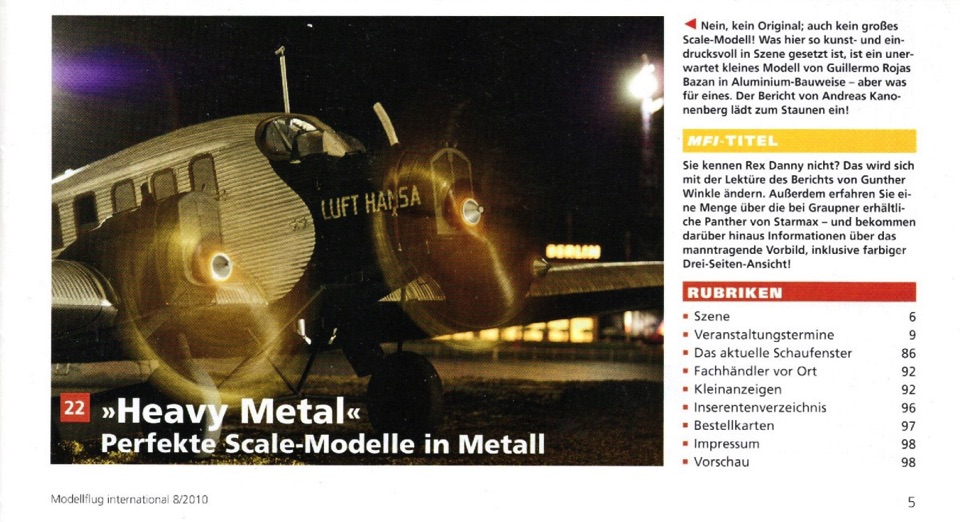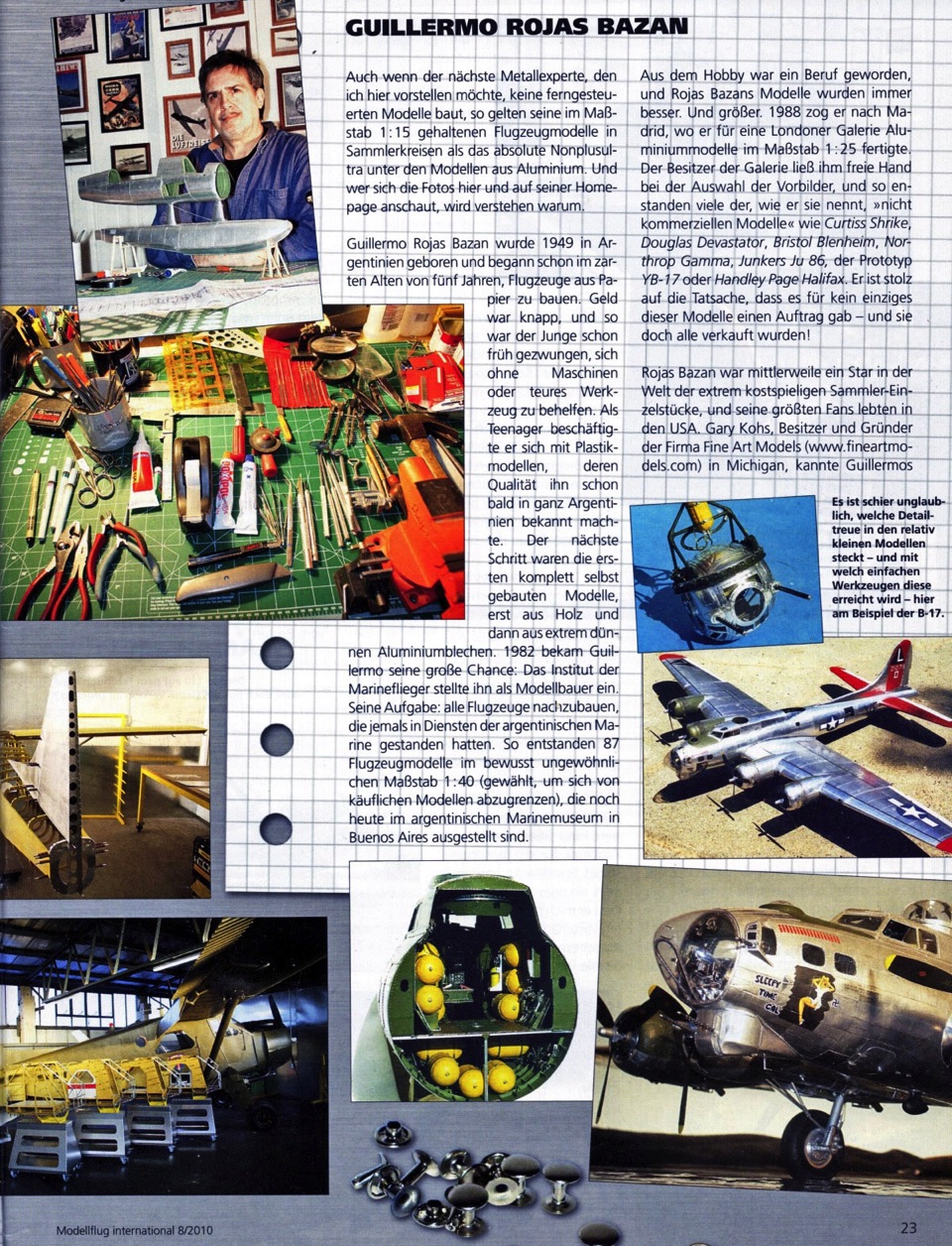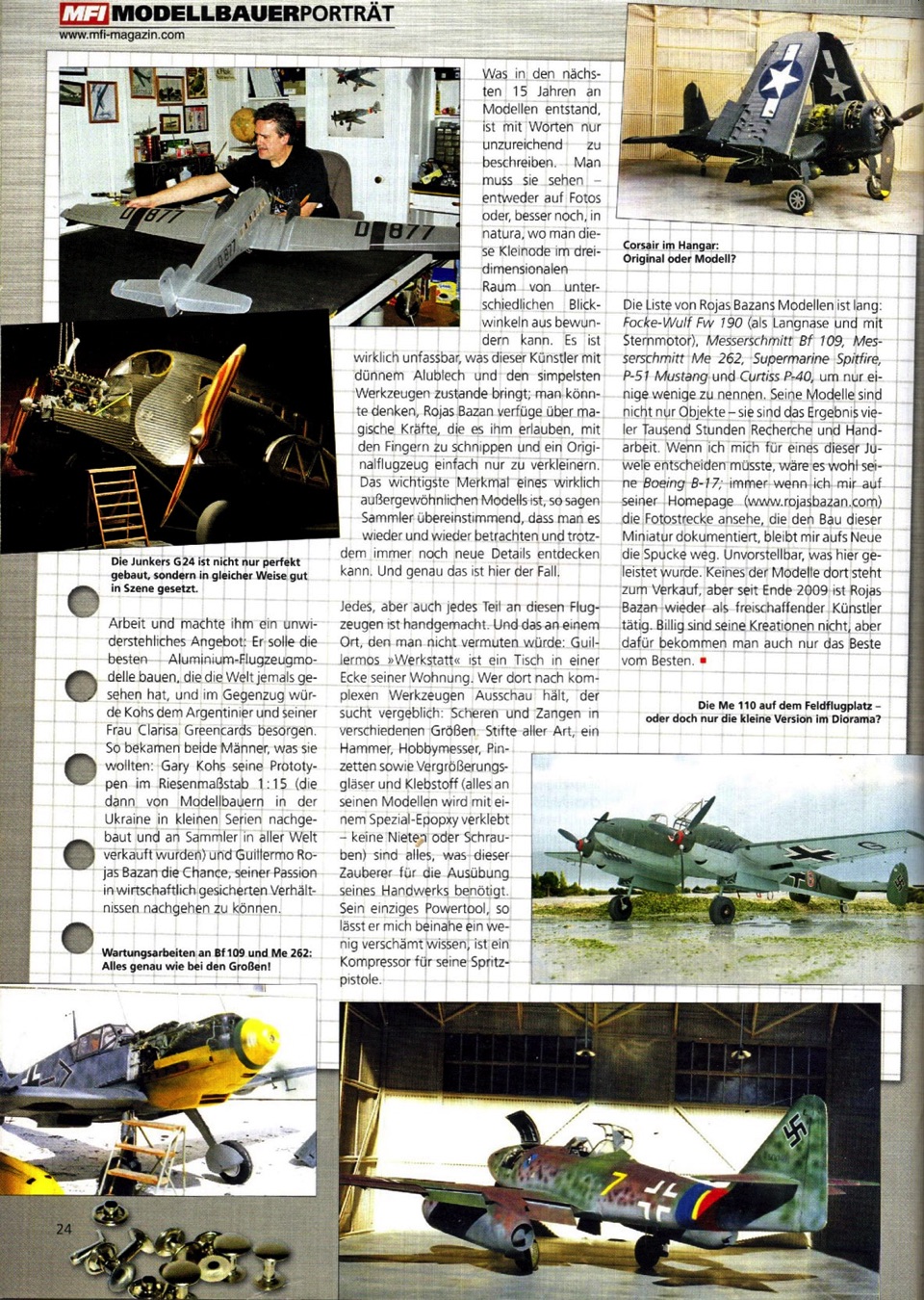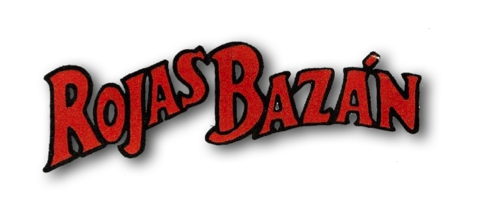TRANSLATION OF MODELLFLUG - 2010
Translation of page 1 (part of cover):
The trade magazine for model flying
In the magazine: Perfect models in metal


Translation of page 2 (Table of Contents):
»Heavy Metal«
Perfect scale models in metal
[Caption] No, not an original; not a large scale model either! What is staged so artistically and impressively here is an unexpectedly small model by Guillermo Rojas Bazan in aluminum construction - but what a model. The report by Andreas Kanonenberg invites you to marvel!

Translation of page 3:
[Caption] The level of detail in the relatively small models is almost unbelievable - and with what simple tools this is achieved - here using the B-17 as an example.
GUILLERMO ROJAS BAZAN
Even though the next metal expert I would like to introduce here does not build remote-controlled models, his 1:15 scale aircraft models are considered by collectors to be the absolute ultimate among aluminum models. And when you see the photos here and on their website, you will understand why.
Guillermo Rojas Bazan was born in Argentina in 1949 and began building paper airplanes at the tender age of five. Money was tight, and so the boy was forced early on to make do without machines or expensive tools. As a teenager he was interested in plastic models, whose quality soon made him known throughout Argentina.
The next step were the first completely self-built models, first made of wood and then made of extremely thin aluminum sheets. In 1982, Guiltermo got his big chance: the Naval Aviation Institute hired him as a model maker. His task: to recreate all the aircraft that had ever been in service with the Argentine Navy.
This resulted in 87 aircraft models in the deliberately unusual scale of 1:40 (chosen to differentiate themselves from commercially available models), which are still on display today in the Argentine Naval Museum in Buenos Aires.
The hobby had turned into a profession, and Rojas Bazan's models were getting better and better. And bigger. In 1988 he moved to Madrid, where he made aluminum models on a scale of 1:25 for a London gallery. The owner of the gallery gave him free rein in the selection of models, and so many of what he calls "non-commercial models" were created: Curtiss Shrike, Douglas Devastator, Bristol Blenheim, Northrop Gamma, Junkers Ju 86, the prototype YB-17 and the Handley Page Halifax. He is proud of the fact that there was no order for any of these models, and yet they were all sold!
Rojas Bazan was now a star in the world of extremely expensive collector's items, and his biggest fans lived in the USA. Gary Kohs, owner and founder of Fine Art Models (www.fineartmodels.com) in Michigan, knew Guillermo's (continues below)

Translation of page 4:
[Caption] The Junkers G24 is not only perfectly built, but also well designed.
[Caption] Corsair in the hangar: original or model?
[Caption] Maintenance work on the Bf 109 and Me 262: Everything is just like the big ones!
[Caption] The Me 110 on the airfield - or just the small version in the diorama?
(continues from above) work and made him an irresistible offer: he would build the best aluminum aircraft models the world has ever seen, and in return Kohs would provide the Argentine and his wife Clarisa green cards.
So both men achieved what they wanted: Gary Kohs his prototypes on a giant scale of 1:15 (which were then recreated in small series by model makers in the Ukraine and sold to collectors all over the world) and Guillermo Rojas Bazan the chance to pursue his passion in secure circumstances.
The models that emerged over the next 15 years cannot be adequately described in words.
You have to see them either in photos or, better yet, in person, where you can admire these gems in three-dimensional space from different angles. It's truly incredible what this artist can achieve with thin aluminum sheet and the simplest of tools. One might think that Rojas Bazan had magical powers that would allow him to snap his fingers and simply shrink an original aircraft.
The most important feature of a truly exceptional model, collectors agree, is that you can look at it again and again and still discover new details. And that is exactly the case here.
Each and every part of these aircraft is handmade. And in a place you wouldn't expect: Guillermo's "workshop" is a table in the corner of his apartment. If you're looking for complex tools there, you'll look in vain: scissors and pliers in different sizes. Pens of all kinds, a hammer, hobby knives, tweezers as well as magnifying glasses and glue (everything on his models is glued with a special epoxy - no rivets or screws) are all this magician needs to practice his craft.
His only power tool, he tells me almost a little bashfully, is a compressor for his spray gun.
The list of Rojas Bazan's models is long: Focke-Wulf Fw 190 (as a long-nose and with a radial engine), Messerschmitt Bf 109, Messerschmitt Me 262, Supermarine Spitfire, P-51 Mustang and Curtiss P-40, to name just a few.
His models are not just objects - they are the result of many thousands of hours of research and handwork. If I had to choose one of these gems, it would probably be his Boeing B-17. Every time I look at the photo series on his website that documents the construction of this miniature (www.rojasbazan.com), I am left salivating all over again.
It's unimaginable what has been achieved here. None of the models are for sale, but since the end of 2009 Rojas Bazan has been working as a freelance artist again. His creations are not cheap, but you only get the best of the best.
